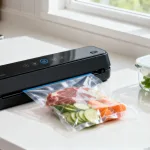Smoked food — tender ribs, juicy brisket, flaky salmon — is a beloved comfort food, but for years, it’s been reserved for professional pitmasters or dedicated hobbyists. Traditional smokers require constant monitoring: you have to check the temperature every hour, add wood chips regularly, and adjust vents to control smoke. It’s time-consuming, stressful, and easy to mess up (overcooked meat, bitter smoke, or under-smoked flavor).
But thanks to smart home smokers, anyone can achieve restaurant-quality smoked foods at home — no pro skills needed. These connected devices take the guesswork out of smoking, with features that let you control temperature, monitor progress, and even receive alerts from your phone. Whether you’re a beginner or a seasoned griller, a smart smoker will elevate your outdoor cooking game.
In this guide, we’ll cover everything you need to know about smart home smokers: why they’re better than traditional models, how to choose the right one for your needs, how to smoke different foods, and how to keep your smoker in top shape.
Why Smart Home Smokers Are Revolutionizing Outdoor Cooking
Traditional smokers (like offset smokers or charcoal smokers) rely on manual controls — and that’s their biggest flaw. Here’s how smart smokers solve the most common pain points of traditional smoking:
- Precision Temperature Control: The #1 rule of smoking is “low and slow” — most foods need to cook at 225°F to 250°F for hours. Traditional smokers fluctuate in temperature (often by 50°F or more) if you don’t adjust the vents or add fuel constantly. Smart smokers use electric heating elements (or pellet-fed systems) and built-in thermometers to maintain a steady temperature (usually ±1°F). This means your ribs cook at exactly 225°F for 6 hours — no more overcooking or undercooking.
- Remote Monitoring & Control: With a traditional smoker, you can’t leave the backyard — if you step inside for 30 minutes, the temperature could drop, ruining your meal. Smart smokers connect to your phone via Bluetooth or Wi-Fi, so you can check the temperature, adjust settings, and even receive alerts (e.g., “Temperature is dropping — add wood chips”) from anywhere in your home (or even while you’re running errands).
- Pre-Programmed Recipes: Not sure how long to smoke a brisket? Or what temperature to use for salmon? Smart smokers come with pre-loaded recipes (or app-based recipe libraries) that tell you exactly how long to cook each food and what temperature to use. For example, the app might say, “Smoke chicken thighs at 250°F for 2.5 hours, then raise to 300°F for 30 minutes to crisp the skin.”
- Less Maintenance: Traditional smokers require you to add charcoal, wood chips, or propane every hour or two. Smart smokers automate this: pellet smokers feed wood pellets into the firebox automatically, and electric smokers use wood chip trays that last 2–3 hours (the app alerts you when it’s time to refill). This means you can relax while your food smokes — no more hovering over the smoker.
- Consistent Flavor: Traditional smokers can produce bitter smoke if the wood chips burn too hot, or weak flavor if the smoke is too thin. Smart smokers control the rate at which wood chips burn, ensuring a steady stream of smoke that infuses food with rich, balanced flavor.
How Smart Home Smokers Work
Smart smokers use one of two main heating systems: electric or pellet. Both are easier to use than traditional charcoal or offset smokers, but they have key differences:
1. Electric Smart Smokers
Electric smokers are the most beginner-friendly option. They use an electric heating element (powered by a standard outlet) to heat the smoker, and a wood chip tray to produce smoke.
How they work:
- You fill the wood chip tray with your choice of wood (hickory, apple, mesquite, etc.).
- You set the desired temperature (via the smoker’s control panel or app).
- The electric element heats the smoker to the set temperature, and the wood chips smolder (not burn) to produce smoke.
- A built-in thermometer monitors the temperature and adjusts the heating element to keep it steady.
- The app alerts you when the wood chips need to be refilled (usually every 2–3 hours) or when the food is done.
Pros:
- Affordable (most cost $200–$400).
- Easy to use (no need to learn about vent control or fuel management).
- Lightweight and compact (good for small patios or balconies).
Cons:
- Less smoky flavor than pellet smokers (since wood chips smolder, not burn).
- Requires an outlet (you can’t use it in areas without electricity).
2. Pellet Smart Smokers
Pellet smokers use compressed wood pellets (made from hardwood like oak, cherry, or pecan) for both heat and smoke. They’re more versatile than electric smokers and produce richer flavor.
How they work:
- You fill a hopper with wood pellets (the hopper holds 5–20 pounds, depending on the model).
- You set the desired temperature (via the control panel or app).
- An auger (a screw-like device) feeds pellets from the hopper into a firepot, where they ignite.
- A fan circulates heat and smoke evenly throughout the smoker.
- The app monitors the pellet level (alerts you when the hopper is low) and the food temperature (some models have a meat probe that inserts into the food to track internal temperature).
Pros:
- Rich, smoky flavor (pellets burn completely, producing more smoke).
- Versatile (can smoke, grill, bake, or roast — some models reach temperatures up to 500°F for searing).
- Low maintenance (hoppers last 8–20 hours, depending on temperature).
Cons:
- More expensive (most cost $300–$800).
- Heavier and bulkier (not ideal for small spaces).
- Requires wood pellets (you can’t use loose wood chips).
Key Features to Look for in a Smart Home Smoker
Whether you choose an electric or pellet smoker, these features will ensure you get the best results:
- Temperature Range: Look for a smoker that can reach 160°F (for cold smoking, e.g., salmon) to 275°F (for hot smoking, e.g., ribs). Pellet smokers should go up to 500°F if you want to grill or sear.
- Meat Probe Compatibility: A built-in meat probe (or the ability to add one) lets you track the internal temperature of your food (e.g., “Brisket is at 195°F — almost done”). This is critical for perfectly cooked meat (overcooked brisket is tough, undercooked chicken is unsafe).
- App Connectivity: The app should let you:
- Set and adjust temperature.
- Monitor food and smoker temperature in real time.
- Receive alerts (low pellets/wood chips, food done, temperature drop).
- Access a recipe library (sorted by food type, e.g., “Pork,” “Seafood,” “Veggies”).
- Save your favorite settings (e.g., “My Ribs Preset: 225°F for 6 hours”).
- Capacity: Consider how much food you’ll smoke at once. Small smokers (1–2 racks) are good for couples or small families. Large smokers (3–4 racks) are better for parties or meal prep. Measure the cooking area (in square inches) to compare models — a 400-square-inch smoker can fit 2 briskets or 4 racks of ribs.
- Insulation: Good insulation keeps the temperature steady (even in cold weather) and reduces energy/pellet usage. Look for smokers with double-walled steel construction or foam insulation.
- Ease of Cleaning: Smoking produces grease and ash, so easy cleaning is a must. Look for:
- Removable grease trays (to catch drippings).
- Ash pans (for pellet smokers — easy to empty).
- Non-stick cooking grates (wipe clean with a brush).
- Weather Resistance: If you’ll keep the smoker outside, look for models with waterproof covers or rust-resistant materials (stainless steel). Electric smokers should have a weatherproof cord.
How to Smoke Different Foods with a Smart Home Smoker
Smoking is versatile — you can smoke meat, seafood, veggies, even cheese! Below are step-by-step guides for the most popular smoked foods, plus tips for perfect results.
1. Smoked Ribs (Pork or Beef)
Ribs are the ultimate smoked food — tender, juicy, and full of flavor.
Ingredients:
- 1 rack of pork spare ribs or beef back ribs.
- Dry rub (e.g., 2 tbsp brown sugar, 1 tbsp paprika, 1 tsp garlic powder, 1 tsp salt, 1 tsp black pepper).
- Wood chips/pellets (hickory or mesquite for pork, oak for beef).
- BBQ sauce (optional, for glazing).
Steps:
- Prep the Ribs:
- Remove the membrane from the back of the ribs (use a butter knife to loosen it, then pull it off — this makes ribs more tender).
- Rub the dry rub all over the ribs, pressing it into the meat. Let the ribs sit at room temperature for 30 minutes (this helps the rub absorb).
- Prep the Smoker:
- Fill the wood chip tray (electric) or hopper (pellet) with your chosen wood.
- Set the smoker temperature to 225°F via the app. Let it preheat for 15–20 minutes (until it reaches 225°F and smoke is coming out).
- Smoke the Ribs:
- Place the ribs on the smoker rack, bone-side down. Insert the meat probe into the thickest part of the meat (avoid touching the bone).
- Smoke the ribs for 3 hours (this is the “smoke” phase — the ribs absorb flavor).
- After 3 hours, wrap the ribs in aluminum foil (add a splash of apple juice or beer to keep them moist). Return to the smoker for 2 hours (the “wrap” phase — ribs tenderize).
- Unwrap the ribs, brush with BBQ sauce (if using), and smoke for 1 more hour (the “glaze” phase — sauce caramelizes).
- Check for Doneness:
- The meat probe should read 195°F–203°F. Ribs are done when the meat pulls away from the bone easily.
Pro Tip: Let the ribs rest for 10 minutes before cutting — this lets the juices redistribute, making them juicier.
2. Smoked Salmon
Smoked salmon is elegant, flavorful, and perfect for breakfast (bagels and cream cheese) or appetizers.
Ingredients:
- 1 pound salmon fillet (skin-on, boneless).
- Brine (1 cup water, 1/4 cup salt, 1/4 cup brown sugar, 1 tsp garlic powder).
- Wood chips/pellets (apple or cherry — mild woods that won’t overpower the salmon).
Steps:
- Brine the Salmon:
- Mix the brine ingredients in a bowl until salt and sugar dissolve.
- Place the salmon in a zip-top bag, pour in the brine. Seal the bag and refrigerate for 4–6 hours (brining keeps salmon moist and adds flavor).
- Remove the salmon from the brine, rinse it under cold water, and pat dry with paper towels. Let it air-dry for 30 minutes (this forms a “pellicle” — a thin layer that helps smoke stick to the fish).
- Prep the Smoker:
- Set the smoker to 160°F (cold smoking) — salmon cooks quickly, so low heat is key.
- Add apple or cherry wood chips/pellets. Preheat for 15 minutes.
- Smoke the Salmon:
- Place the salmon on the smoker rack, skin-side down. Insert the meat probe into the thickest part.
- Smoke for 1.5–2 hours, until the internal temperature reaches 145°F.
- Serve:
- Let the salmon cool slightly, then flake it with a fork or slice it thinly.
Pro Tip: For extra flavor, add fresh dill to the brine or sprinkle it on the salmon before smoking.
3. Smoked Vegetables
Smoked veggies are a delicious side dish — they’re sweet, smoky, and pair well with grilled or smoked meat.
Ingredients:
- Veggies (bell peppers, zucchini, mushrooms, onions, carrots, or potatoes).
- Olive oil (2 tbsp).
- Salt, pepper, and garlic powder (to taste).
- Wood chips/pellets (apple or pecan — mild woods).
Steps:
- Prep the Veggies:
- Cut veggies into uniform pieces (e.g., bell peppers into strips, zucchini into rounds, potatoes into chunks). This ensures they cook evenly.
- Toss veggies with olive oil, salt, pepper, and garlic powder.
- Prep the Smoker:
- Set the smoker to 225°F. Preheat for 15 minutes.
- Smoke the Veggies:
- Place veggies on the smoker rack (use a grill basket for small veggies like mushrooms to prevent them from falling through).
- Smoke for 45–60 minutes, stirring halfway through. Veggies are done when they’re tender and have a smoky color.
Pro Tip: For extra creaminess, smoke cauliflower florets, then blend them into soup.
Pro Tips for Mastering Smart Smoking (and Avoiding Common Mistakes)
Even with a smart smoker, there are a few things to keep in mind to ensure perfect results:
- Choose the Right Wood: Different woods produce different flavors — match the wood to your food:
- Mild woods (apple, cherry, pecan): Best for fish, chicken, veggies, and pork.
- Strong woods (hickory, mesquite): Best for beef, brisket, and ribs (they stand up to bold flavors).
- Avoid soft woods (pine, cedar) — they produce bitter smoke.
- Don’t Overcrowd the Smoker: Leave space between food items so air and smoke can circulate. Overcrowding leads to uneven cooking (some foods will be done before others).
- Avoid Opening the Smoker Door Too Often: Every time you open the door, heat and smoke escape — this increases cooking time and can ruin the flavor. Use the app to monitor temperature instead of checking in person.
- Let Meat Rest Before Serving: Resting meat (10–15 minutes for ribs, 30 minutes for brisket) lets the juices redistribute. If you cut meat immediately, the juices will run out, making it dry.
- Clean the Smoker After Every Use: Grease and ash build up over time, which can affect flavor and cause rust. Wipe down the grates, empty the grease tray, and clean the wood chip tray/hopper after each use.
Maintaining Your Smart Home Smoker for Long-Lasting Performance
A well-maintained smart smoker can last 5–10 years. Follow these tips to keep it in top shape:
- Regular Cleaning:
- After each use: Wipe the cooking grates with a wire brush (while they’re still warm — food comes off easier). Empty the grease tray and ash pan (for pellet smokers).
- Once a month: Deep clean the smoker. Remove the grates and soak them in warm, soapy water for 30 minutes. Wipe the interior with a damp cloth (avoid using harsh chemicals — they can leave a residue). Clean the meat probe with a damp cloth (don’t submerge it in water).
- Store It Properly:
- If you live in a cold climate, store the smoker indoors during winter (or use a weatherproof cover). Freezing temperatures can damage the electric element or auger.
- For pellet smokers: Empty the hopper of pellets before storing (pellets absorb moisture and can clump, which clogs the auger).
- Check for Wear and Tear:
- Inspect the power cord (for electric smokers) or hopper (for pellet smokers) regularly. If the cord is frayed or the hopper has cracks, replace them immediately (contact the manufacturer for parts).
- Test the meat probe every few months: Insert it into a pot of boiling water (212°F at sea level) — it should read 212°F. If it’s off by more than 5°F, calibrate it (follow the manufacturer’s instructions) or replace it.
- Update the App:
- Brands often release app updates with new features (e.g., new recipes) or bug fixes. Keep the app updated to ensure your smoker works properly.
Final Thoughts
Smart home smokers have made smoked food accessible to everyone — you no longer need to be a pitmaster to achieve tender, flavorful ribs or juicy brisket. With precision temperature control, remote monitoring, and pre-programmed recipes, a smart smoker takes the stress out of outdoor cooking and lets you focus on enjoying time with family and friends.
Whether you choose an electric smoker (beginner-friendly, affordable) or a pellet smoker (rich flavor, versatile), the key is to start small. Smoke ribs or salmon first — they’re easy to cook and forgiving if you make a mistake. As you gain confidence, you can move on to more challenging foods like brisket or pulled pork.
Investing in a smart smoker isn’t just about buying a kitchen tool — it’s about creating memories: weekend barbecues with friends, Sunday mornings with smoked salmon and bagels, and weeknight meals that taste like they came from a restaurant.

















